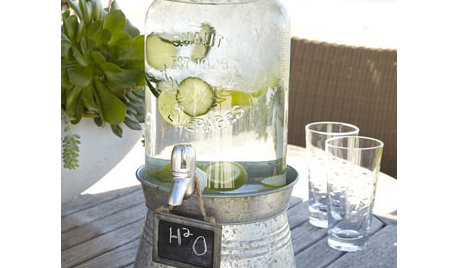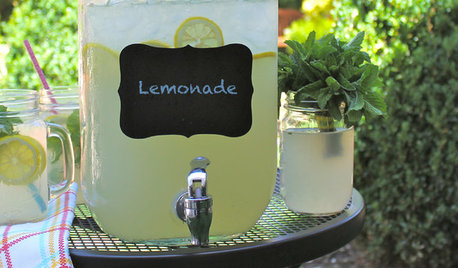This makes for about five gallons. Scale it down if you need to, and be aware that it is a very flexible recipe, so feel free to alter some of the ingredients to suit your own taste.
Old-fashioned Ginger beer
8 lbs of sugar
5-6 ozs of ginger root, sliced very thin
5 gallons of water
Any combination of lemons and limes equalling 10-12 total. More lemons than limes tastes better to me. The limes will give a bit of sparkle and body to the flavor. Try a combination of 3/4 lemons to 1/4 limes, or 2/3 to 1/3. Use a potato peeler or sharp knife to remove the outer skins from these while avoiding as much of the white rind as possible. The rind tends to make the brew bitter.
Squeeze the juice from the lemons and limes. Remove any seeds from the juice.
Yeast I use a yeast suitable for a light beer such as a pilsner. I am sure that other yeast types would work but, I can't vouch for the flavor or the readiness of the brew to be had very young.
------------------------------------------------
Heat about a gallon or so of the water to boiling and add the sugar. When the sugar has dissolved some what then go ahead and add the ginger. Continue simmering for twenty minutes or so after the sugar has completely dissolved.
Turn off the heat. Add the lemon/lime juice and peels after the water has cooled just a little, about ten minutes or so.
Place mixture in fermenting vessel with enough of the remaining water to make for 5 gallons. You may wish to use a must bag for the peels and ginger slices.
Allow the temperature to cool down to about 70 degrees, then add the yeast. Attach the air lock to the fermentation vessel.
Depending on how warm the vessel is kept this will be ready to bottle in about two weeks. Wait for the fermentation action to come to a slow 'perk'. If you wait too long your finished beer will not have enough sugar left in it and it will be sour and rather flat. Too soon and you will have a ginger beer bombing strafe going on in your storage closet! I wish I could be of more assistance to you as to timing suggestions but, I leave you to your own judgement on that. Just remember that one needs to find a happy medium between too flat, or explosive.
When you are either satisfied that it is time, or antsy to go to the next step, then proceed with bottling the brew.
I know that some folks will cringe here to what I am about to advise, but after a few exploding bottles I opted to try pint-sized screw top soda bottles. Yes, I know, plastic! I don't like plastic either. Never the less I have never had a plastic bottle explode, and if I test one bottle out and find that it is overly effervescent I can go through the rest and very gently unscrew the caps a little to let off a bit of the pressure. That seems to me a much easier and safer solution to bottling the stuff than risking what could be dangerous glass bottles. Believe me this stuff can really bubble!
When you bottle the brew it will probably still be rather cloudy. Don't worry about that. The brew will clear itself considerably inside the bottle while under compression. It will be ready to drink in no time at all after bottling, once you are satisfied with its clarity and fizz.
Also take it slow when opening the screw tops, as you would with a shaken soda, a little at a time and reclosing it if it's about to foam over. This ginger beer can produce a real fountain of fizz at times even when unshaken. If you should add sugar to it after it has been bottled because the beer is too sour that can also cause a fountain effect, similar to what happens when you mix baking soda with vinegar, WOOSH! So please be aware of that, too. I once had a bottle almost entirely empty itself from my doing that! And there was no getting the cap back on to stop the deluge. I've never tried doing that again!
I enter these cautions here hoping that it does not put you off of trying to make a batch of ginger beer. I have had many successful batches. It is simply prudent to advise you all of what can go wrong, and what to avoid.
I hope that some of you find this recipe enjoyable, and that you will share your experiences of brewing it with me. Please feel free to experiment with the recipe, it is very forgiving.
Blessings to all,
OzarkMtMan













biblion
kristie8888
Related Discussions
LOOKING for: Old fashioned Popcorn balls
Q
Recipe for 'old-fashioned' chili dogs?
Q
LOOKING for: Old fashioned soft spice cookie
Q
MOM's Aussie Ginger Beer Recipe
Q
tgrebe
Erica Evans